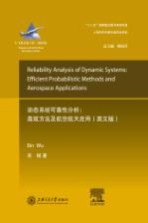
- 作 者:吴斌著
- 出 版 社:上海:上海交通大学出版社
- 出版年份:2013
- ISBN:9787313101709
- 标注页数:202 页
- PDF页数:222 页
请阅读订购服务说明与试读!
订购服务说明
1、本站所有的书默认都是PDF格式,该格式图书只能阅读和打印,不能再次编辑。
2、除分上下册或者多册的情况下,一般PDF页数一定要大于标注页数才建议下单购买。【本资源222 ≥202页】
图书下载及付费说明
1、所有的电子图书为PDF格式,支持电脑、手机、平板等各类电子设备阅读;可以任意拷贝文件到不同的阅读设备里进行阅读。
2、电子图书在提交订单后一般半小时内处理完成,最晚48小时内处理完成。(非工作日购买会延迟)
3、所有的电子图书都是原书直接扫描方式制作而成。
1.Introduction 1
1.1 Structural Reliability Analysis 1
1.2 Non-deterministic Reliability Analysis Methods 6
1.2.1 Monte Carlo Simulation(MCS)Method 6
1.2.2 FORM(First-order Reliability Method) 7
1.2.3 Interval Analysis 9
1.2.4 Fuzzy Analysis 10
1.2.5 Response Surface Method(RSM) 11
1.2.6 Summary 12
1.3 Uncertainty Analysis of Dynamic Systems 13
1.3.1 Background 13
1.3.2 Literature Review of Analytical Approaches to Dynamic Systems 15
1.3.3 Summary 22
1.4 Scope of the Present Work 23
1.5 Overview of the Book 23
2.Technical Background 25
2.1 Definition of Structural Reliability 25
2.2 Technical Basis of the Monte Carlo Simulation Method 26
2.3 Theory of the First-order Reliability Method(FORM) 30
2.4 Response Surface Method 34
2.4.1 Response Surface Models and Fitting Techniques 34
2.4.2 Sampling Design Methods 36
2.5 Problems of Applying FORM and RSM Methods to Dynamic Systems 39
2.5.1 Problematic Failure Surfaces for FORM Applications 39
2.5.2 Inaccuracy of RSM in Predicting the Dynamic Response 40
2.6 Optimization Solution Through Modal Analysis 41
3.Theoretical Fundamentals of the Perturbation Approach 43
3.1 Definition of the New Parameters and Safety Margin 43
3.2 Derivation of the Two Moments of the New Parameters 47
3.2.1 Derivation of the Covariance Matrix of the Modal Parameter ω2 48
3.2.2 Derivation of the Covariance Matrix of the Defined Parameter dr 52
3.2.3 Derivation of the Covariance Matrix of the Modal Parameter[Ф] 54
3.2.4 Derivation of the Covariance Matrix of the Defined Parameter rjk,r 58
3.2.5 Derivation of the Covariance Matrix of the Combined Parameter T 62
3.2.6 Derivation of the Mean Values of the Defined Parameters dr and rjk,r 63
3.3 Application Procedure of the New Approach 64
3.4 Discussion 65
3.5 Summary 66
4.Application to a 2D System 69
4.1 Finite Element Model of a 2D Dynamic System 69
4.2 Applying the Combined Approach:Preliminary Analysis 74
4.2.1 Response Analysis 76
4.2.2 Safety Margin Contour 78
4.3 Perturbation Approach+FORM Method 81
4.3.1 Evaluating the Probability of Failure and In-depth Analysis 81
4.3.2 Solution 1:Second-order Approximation of d2 89
4.3.3 Solution 2:New Variable e2 to Replace d2 101
4.3.4 Solution 3:Variable ω2 2 to Replace e2 104
4.4 Solution 4:Monte Carlo Simulation Replacing FORM 111
4.4.1 Perturbation+Monte Carlo Simulation on r2 and ω2 2 112
4.4.2 Reliability Analysis of the Updated Combined Approach 113
4.5 Summary 116
5.Application to a 3D Helicopter Model 119
5.1 Background of Helicopter Vibration Control 119
5.2 A 3D Helicopter FE Model 120
5.2.1 System Details 120
5.2.2 Dynamic Characteristics of the Model 123
5.3 Response Analysis 128
5.4 Reliability Analysis of the Combined Approach 129
5.4.1 Probability vs.Excitation Frequencies 129
5.4.2 Probability vs.Maximum Displacement and Variation Coefficient 132
5.5 Efficiency Analysis 135
5.6 Summary 137
6. Complete Combined Approach 141
6.1 Response Surface Techniques in Obtaining Ck 141
6.1.1 Direct RS Model Fitting of the Stiffness Matrix K 141
6.1.2 Alternative Fitting Approach 143
6.1.3 Analytical Approach to Obtain the Covariance Matrix of K 147
6.1.4 Complete Combined Approach 149
6.2 Complete Application to 2D Frame Model 149
6.2.1 Type I RS Model Fitting with Koshal Design 149
6.2.2 Complete Combined Approach 151
6.3 Complete Application to 3D Helicopter Model 155
6.4 Summary 157
7. Conclusions and Future Work 159
7.1 Achievements and Conclusions 159
7.2 Future Work 160
7.2.1 Application of an Enhanced FORM Method 161
7.2.2 Further Simplification of Perturbation/Analytical Algorithms 163
7.2.3 Development for Non-Probabilistic Methods 163
Appendix Ⅰ:Transforming Random Variables from Correlated to Uncorrelated 165
Appendix Ⅱ:Analytical Solution of HL Safety Index 167
Appendix Ⅲ:Modal Analysis of Dynamic Systems 169
Appendix Ⅳ:Multiple Force Analysis 173
Appendix Ⅴ:Summary of the Defined Parameters 179
Appendix Ⅵ:Nodal Coordinates of the Helicopter Model 185
Appendix Ⅶ:Element Connectivity and Properties of the Helicopter Model 187
References 191
Index 199
